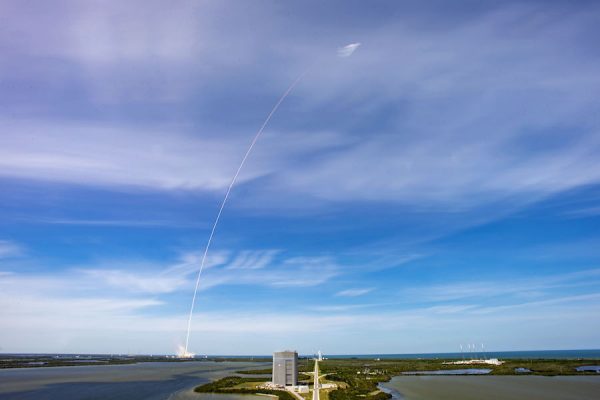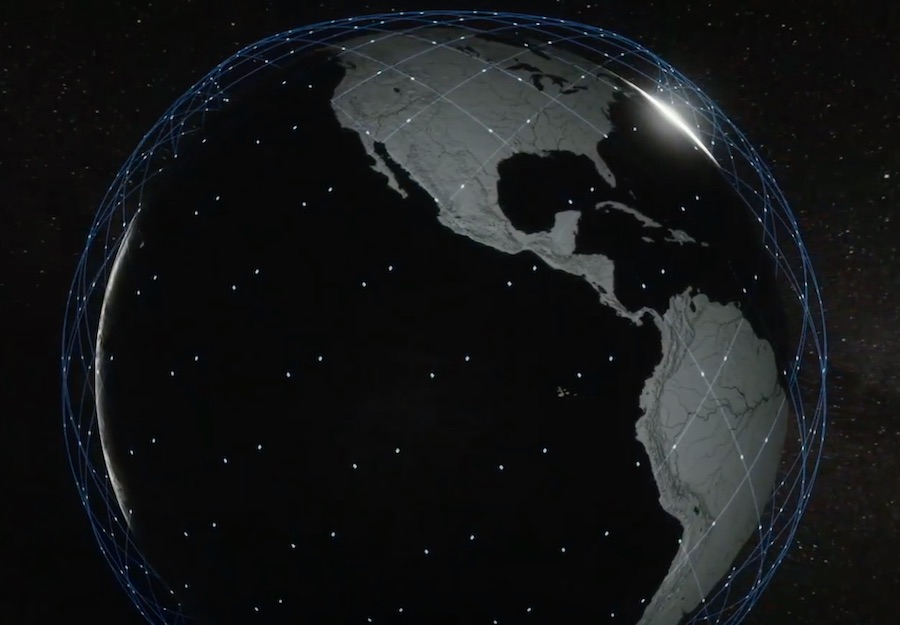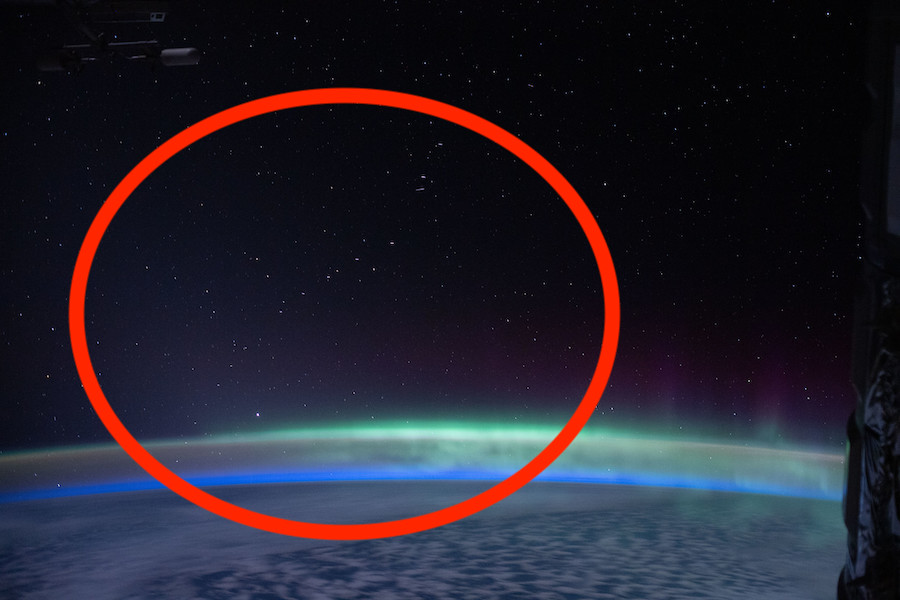SpaceX’s Starlink network surpasses 400-satellite mark after successful launch – Spaceflight Now

SpaceX launched 60 more spacecraft Wednesday to join the Starlink fleet beaming broadband signals around the world, while the company’s engineers move closer to debuting a sunshade that could reduce the satellites’ impacts on ground-based astronomy.
Riding 1.7 million pounds of thrust from nine Merlin main engines, a Falcon 9 rocket took off at 3:30:30 p.m. EDT (1930:30 GMT) Wednesday from pad 39A at NASA’s Kennedy Space Center in Florida.
The Falcon 9 launcher, standing 229 feet (70 meters) tall, tilted on a track northeast from Florida’s Space Coast and rocketed through a thin layer of high clouds on the way to orbit.
Two-and-a-half minutes after liftoff, the Falcon 9’s first stage booster shut down and separated to begin a controlled descent back into the atmosphere. The rocket’s single-engine upper stage ignited seconds later, and the Falcon 9 released its clamshell-like payload fairing more than three minutes into the mission.
Flying into space for the fourth time, the reusable first stage nailed a pinpoint landing on SpaceX’s drone ship in the Atlantic Ocean east of Charleston, South Carolina. Two recovery ships were stationed in the Atlantic to retrieve the rocket’s two-piece payload shroud, which was also recycled from a previous flight.
Here’s a replay of today’s launch from the Kennedy Space Center — the 84th by a SpaceX Falcon 9 rocket since 2010.
That makes the Falcon 9 the most-flown orbital-class US launch vehicle currently operational. https://t.co/8hPfnSTULV pic.twitter.com/zpkdKgNwkW
— Spaceflight Now (@SpaceflightNow) April 22, 2020
The Falcon 9 rocket released retention rods holding the Starlink satellites to the upper stage around 15 minutes after launch. Video from camera on the rocket showed the 60 flat-panel satellites — each with mass of about a quarter-ton — receding into space over the North Atlantic Ocean.
The satellites were each expected to extend their power-generating solar panel wing go through an activation sequence. Krypton ion thrusters on the spacecraft will boost them from their preliminary elliptical transfer orbit to an operational altitude of 341 miles (550 kilometers) over the coming weeks and months.
The successful launch Wednesday marked the 84th flight of a Falcon 9 rocket since June 2010. That makes SpaceX’s Falcon 9 the most-flown orbital-class U.S. launcher currently in operation, exceeding the 83 missions performed by the Atlas 5 rocket built by rival United Launch Alliance.
Wednesday’s launch was SpaceX’s seventh Falcon 9 mission of the year.
It was the first Falcon 9 launch since March 18, when one of the Falcon 9’s nine Merlin booster engines shut down prematurely. The rocket was able to recover from the engine failure, and still placed its payload of 60 Starlink satellites into the planned orbit.
Elon Musk, SpaceX’s founder and CEO, said Wednesday the engine problem was caused by a “small amount of isopropyl alcohol (cleaning fluid)” that was trapped in a “sensor dead leg,” or an area where it couldn’t flow through. The fluid ignited in flight, causing the engine to automatically shut down.
Lauren Lyons, a SpaceX engineer hosting the company’s launch webcast, said ground crews did not perform that particular cleaning procedure on the Falcon 9 rocket used Wednesday.
SpaceX’s next 60 Starlink satellites have deployed in orbit after a successful launch aboard a Falcon 9 rocket.
This gives SpaceX more than 400 satellites for its broadband Internet project. https://t.co/8hPfnSTULV pic.twitter.com/EoqyRzzu4b
— Spaceflight Now (@SpaceflightNow) April 22, 2020
With Wednesday’s launch, SpaceX has delivered 422 Starlink satellites to space, including two prototypes that are now being deorbited. Since last May, SpaceX has orbited 420 Starlink spacecraft. Three of those relay stations are no longer in orbit, according to publicly-available U.S. military tracking data.
SpaceX’s next Starlink launch after Wednesday could happen as soon as early May on another Falcon 9 rocket mission from Cape Canaveral.
That will be followed by SpaceX’s first launch with astronauts on-board — scheduled for May 27 — to begin a test flight of the company’s Crew Dragon spaceship to the International Space Station.
SpaceX seeks to modify Starlink regulatory license
SpaceX has regulatory approval from the Federal Communications Commission to eventually field a fleet of up to 12,000 small Starlink broadband stations.
Officials say 24 launches are needed to provide global broadband service through the Starlink service. But the company could provide an interim level of service over parts of the Earth — such as Canada and northern parts of the United States — later this year, once SpaceX has launched around 720 satellites on 12 Falcon 9 flights.
SpaceX has modified the architecture of the Starlink network several times. Most recently, SpaceX submitted an application to the Federal Communication Commission on Friday proposing to operate more satellites in lower orbits than the FCC previously authorized.
The first phase of the Starlink network will include 1,584 satellites orbiting 341 miles (550 kilometers) above Earth in planes inclined 53 degrees to the equator. That part of the constellation, which SpaceX intends to launch through the end of the year, remains unchanged in SpaceX’s application.
SpaceX previously had regulatory approval from the FCC to operate another 2,825 satellites in higher orbits between 690 miles (1,110 kilometers) and 823 miles (1,325 kilometers) in altitude, in orbital planes inclined 53.8, 70, 74 and 81 degrees to the equator.

The modified plan submitted to the FCC by SpaceX foresees Ku-band and Ka-band satellites in the next phase of the Starlink network all operated at altitudes between 335 miles (540 kilometers) and 354 miles (570 kilometers) at inclinations of 53.2, 70 and 97.6 degrees.
The application covers 4,408 Starlink satellites, one fewer than SpaceX envisioned under the previous architecture.
In documentation submitted Friday to the FCC, SpaceX said lower altitude will put the satellites closer to Starlink consumers and allow the network “to provide low-latency broadband to unserved and underserved Americans that is on par with service previously only available in urban areas.”
The change will also improve Starlink service for U.S. government users in polar regions and allow for more rapid deployment of the network, SpaceX said.
Flying Starlink satellites in lower orbits will help ensure they re-enter the atmosphere a shorter time in case of failure. And the spacecraft will broadcast signals at reduced power levels because they are closer to Earth, which SpaceX said will allow the Starlink fleet to be compliant with limits to reduce radio interference with other satellite and terrestrial wireless networks.
Last week’s application to modify SpaceX’s FCC license is the latest in a series of adjustments to the Starlink architecture. Before the first launch of 60 Starlink satellites last year, SpaceX received FCC approval to migrate the positions of the fleet’s first 1,584 satellites from 714 miles (1,150 kilometers) to 341 miles (550 kilometers).
In December, the FCC granted a SpaceX request to reconfigure the distribution of the Starlink satellites in different orbital planes. SpaceX said that request was intended to expand Starlink coverage faster around the United States without the need for more satellites.
SpaceX working on sunshade for future Starlink satellites
At lower altitudes, the Starlink satellites will fly in a region with busier space traffic. SpaceX says its Starlink spacecraft can maneuver to avoid collisions with other objects in orbit, and it releases orbital data on the Starlink satellites so other operators can also perform evasive maneuvers.
Astronomers have also raised concerns about the brightness of the Starlink satellites, which could interfere with ground-based telescope images, particularly around sunrise and sunset.
The Starlink satellites reflect more sunlight than SpaceX or astronomers anticipated before the first dedicated Starlink launch last year. The American Astronomical Society and other groups are working with SpaceX to try and limit the satellites’ impacts on astronomy.
One of the ground-based facilities most at risk of interference from the Starlink satellites is the U.S. government-funded Vera Rubin Observatory, formerly known as the Large Synoptic Survey Telescope. The observatory under construction in Chile will capture deep, wide-field images of the entire southern sky, allowing astronomers to learn more about dark energy and dark matter, and detect potentially hazardous asteroids with orbits near Earth, among other objectives.
Steve Kahn, director of the Vera Rubin Observatory, said Wednesday that SpaceX is responsive to astronomers’ concerns.
“They’ve been quite cooperative in working with us,” Kahn told Spaceflight Now in an interview.
“SpaceX is committed to promoting all forms of space exploration, which is why it has already taken a number of proactive steps to ensure it does not materially impact optical astronomy,” the company wrote in Friday’s application to the FCC, which does not have regulatory authority over the brightness of satellites. “SpaceX is working with U.S. and international astronomy organizations and observatories to measure scientifically the actual impact of its satellites.”
Flying more Starlink satellites at lower altitudes could make the relay nodes appear brighter from the ground, but there will be fewer Starlink satellites visible in the sky at one time. The spacecraft at lower altitudes will also spend less time illuminated by sunlight.
“In some respects, that’s good for astronomy because the Earth’s shadow is a cone,” said Pat Seitzer, an astronomer and orbital debris expert at the University of Michigan. “So the satellites at higher altitude will be visible longer into the darkest part of the night, but because they’re closer now, they’ll be brighter. So we’ll just have to sort out and see how that works.”
Seitzer agreed with SpaceX that the lower operating altitude for the Starlink satellites “really helps them for space safety, in terms of space debris or orbital debris considerations.”

One of 60 Starlink satellites launched Jan. 6 carried a new darker coating intended to reduce the spacecraft’s reflectivity. SpaceX said last month that preliminary data indicated a “notable reduction” in the brightness of that satellite, which has been dubbed “DarkSat.”
“The darkening that they did on DarkSat is about a factor of two-and-a-half fainter — so about 1 magnitude in astronomical units — and it’s still visible to the unaided eye under excellent conditions,” Seitzer said. “That is you’re a person with great vision sitting on top of a mountaintop faraway from the city lights.”
Kahn agreed, adding that the darker coating was a step in the right direction for astronomers.
“Beyond this (darkening) treatment, SpaceX is developing new mitigation efforts that it plans to test in the coming months,” SpaceX wrote in Friday’s FCC filing. “Additionally, SpaceX will make satellite tracking data available so astronomers can better coordinate their observations with our satellites.”
One change SpaceX is studying is the addition of a sunshade, or visor, to unfurl like an umbrella on Starlink satellites to reduce the amount of sunlight glinting off the spacecraft.
Musk tweeted Wednesday that SpaceX is taking “key steps to reduce satellite brightness.” He wrote that the satellites “should be much less noticeable” when they’re flying at lower altitudes soon after launch.
He said SpaceX is changing the angle of each satellite’s solar panel, and all of the Starlink satellites will have sunshades beginning with the fleet’s ninth launch. That launch is expected in a couple of months.
Beyond the 4,400 Ku-band and Ka-band satellites covered in Friday’s application for a modified FCC license, SpaceX plans to launch another 7,500 V-band data relay stations into orbits around 214 miles (345.6 kilometers) in altitude. The FCC has already approved SpaceX to operate the V-band network.
Email the author.
Follow Stephen Clark on Twitter: @StephenClark1.






